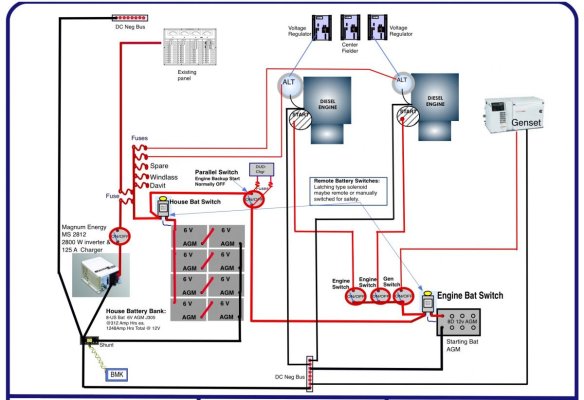Eddie W
Veteran Member
- Joined
- Sep 19, 2019
- Messages
- 63
- Location
- usa
- Vessel Name
- Tidal Holm
- Vessel Make
- Mainship 34 MK1 1982
Soon I will be attacking my boats wiring. Plans are to inspect, repair and/or replace all the factory wiring and to replace all the wiring that has been added over the years. My best friend is a retired Navy Guy (electronic Genius) who will act as my mentor and inspector, we co-owned a sailboat several years ago and did a complete refit including all the electrical , so this will not be our first job together .
I currently have a ProMariner 1240P charger which is adequate for what I have on the boat now, but plan to do some upgrades down the road. As many know the charger has three banks and I am currently only using two. I have a couple questions and any insight would be appreciated, from what I learn here, I can bounce it off my friend as we set forth a plan.
Do you have more than one charger onboard? I like the Promariner I have and would like to add a second 1240P or even a 1260P.
Currently batteries are located in four different spots, bow thruster and anchor windlass batteries are right next to the bow thruster and windlass and I plan on keeping them there, I like the shorter run on the cables and will upgrade them to one size larger than needed. Your thoughts on this?
House and start batteries are in 3 separate locations, I will consolidate these into hopefully one possibly two locations. House and start batteries consist of 6 batteries, two group 24 12v for engine start and Gen Start, four 6 volt golf cart batteries for house and inverter bank. Battery boxes and hold downs are in the plans and if I set them up in two locations, when I add more batteries for house, I will be ahead of the game. Any thoughts?
Currently the boat has 430 amp hours for house, all the batteries are one to two years old, so by the time I am ready to upgrade the house bank ( 1 to 2 years) I will probably be replacing what I have. Our plans are to do the loop in 2021, using this year to get the boat and us ready. And we will spend some time in the Bahamas when we finish the loop, thats when we want to have our house bank upgraded so we can spend more time on the hook. We have an Onan 8kw genset and not quite sure yet about the charging capacity of the Perkins.
I currently have a ProMariner 1240P charger which is adequate for what I have on the boat now, but plan to do some upgrades down the road. As many know the charger has three banks and I am currently only using two. I have a couple questions and any insight would be appreciated, from what I learn here, I can bounce it off my friend as we set forth a plan.
Do you have more than one charger onboard? I like the Promariner I have and would like to add a second 1240P or even a 1260P.
Currently batteries are located in four different spots, bow thruster and anchor windlass batteries are right next to the bow thruster and windlass and I plan on keeping them there, I like the shorter run on the cables and will upgrade them to one size larger than needed. Your thoughts on this?
House and start batteries are in 3 separate locations, I will consolidate these into hopefully one possibly two locations. House and start batteries consist of 6 batteries, two group 24 12v for engine start and Gen Start, four 6 volt golf cart batteries for house and inverter bank. Battery boxes and hold downs are in the plans and if I set them up in two locations, when I add more batteries for house, I will be ahead of the game. Any thoughts?
Currently the boat has 430 amp hours for house, all the batteries are one to two years old, so by the time I am ready to upgrade the house bank ( 1 to 2 years) I will probably be replacing what I have. Our plans are to do the loop in 2021, using this year to get the boat and us ready. And we will spend some time in the Bahamas when we finish the loop, thats when we want to have our house bank upgraded so we can spend more time on the hook. We have an Onan 8kw genset and not quite sure yet about the charging capacity of the Perkins.

